| Listing 1 - 9 of 9 |
Sort by
|
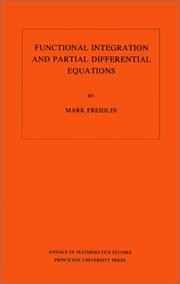
ISBN: 0691083541 1400881595 Year: 1985 Publisher: Princeton, N.J.
Abstract | Keywords | Export | Availability | Bookmark
 Loading...
Loading...Choose an application
- Reference Manager
- EndNote
- RefWorks (Direct export to RefWorks)
This book discusses some aspects of the theory of partial differential equations from the viewpoint of probability theory. It is intended not only for specialists in partial differential equations or probability theory but also for specialists in asymptotic methods and in functional analysis. It is also of interest to physicists who use functional integrals in their research. The work contains results that have not previously appeared in book form, including research contributions of the author.
Partial differential equations --- Differential equations, Partial. --- Probabilities. --- Integration, Functional. --- Functional integration --- Functional analysis --- Integrals, Generalized --- Probability --- Statistical inference --- Combinations --- Mathematics --- Chance --- Least squares --- Mathematical statistics --- Risk --- A priori estimate. --- Absolute continuity. --- Almost surely. --- Analytic continuation. --- Axiom. --- Big O notation. --- Boundary (topology). --- Boundary value problem. --- Bounded function. --- Calculation. --- Cauchy problem. --- Central limit theorem. --- Characteristic function (probability theory). --- Chebyshev's inequality. --- Coefficient. --- Comparison theorem. --- Continuous function (set theory). --- Continuous function. --- Convergence of random variables. --- Cylinder set. --- Degeneracy (mathematics). --- Derivative. --- Differential equation. --- Differential operator. --- Diffusion equation. --- Diffusion process. --- Dimension (vector space). --- Direct method in the calculus of variations. --- Dirichlet boundary condition. --- Dirichlet problem. --- Eigenfunction. --- Eigenvalues and eigenvectors. --- Elliptic operator. --- Elliptic partial differential equation. --- Equation. --- Existence theorem. --- Exponential function. --- Feynman–Kac formula. --- Fokker–Planck equation. --- Function space. --- Functional analysis. --- Fundamental solution. --- Gaussian measure. --- Girsanov theorem. --- Hessian matrix. --- Hölder condition. --- Independence (probability theory). --- Integral curve. --- Integral equation. --- Invariant measure. --- Iterated logarithm. --- Itô's lemma. --- Joint probability distribution. --- Laplace operator. --- Laplace's equation. --- Lebesgue measure. --- Limit (mathematics). --- Limit cycle. --- Limit point. --- Linear differential equation. --- Linear map. --- Lipschitz continuity. --- Markov chain. --- Markov process. --- Markov property. --- Maximum principle. --- Mean value theorem. --- Measure (mathematics). --- Modulus of continuity. --- Moment (mathematics). --- Monotonic function. --- Navier–Stokes equations. --- Nonlinear system. --- Ordinary differential equation. --- Parameter. --- Partial differential equation. --- Periodic function. --- Poisson kernel. --- Probabilistic method. --- Probability space. --- Probability theory. --- Probability. --- Random function. --- Regularization (mathematics). --- Schrödinger equation. --- Self-adjoint operator. --- Sign (mathematics). --- Simultaneous equations. --- Smoothness. --- State-space representation. --- Stochastic calculus. --- Stochastic differential equation. --- Stochastic. --- Support (mathematics). --- Theorem. --- Theory. --- Uniqueness theorem. --- Variable (mathematics). --- Weak convergence (Hilbert space). --- Wiener process.
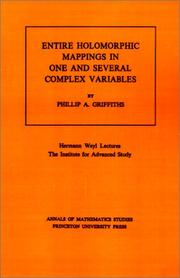
ISBN: 0691081719 0691081727 140088148X 9780691081724 9780691081717 Year: 1976 Volume: no. 85 Publisher: Princeton, N.J.
Abstract | Keywords | Export | Availability | Bookmark
 Loading...
Loading...Choose an application
- Reference Manager
- EndNote
- RefWorks (Direct export to RefWorks)
The present monograph grew out of the fifth set of Hermann Weyl Lectures, given by Professor Griffiths at the Institute for Advanced Study, Princeton, in fall 1974.In Chapter 1 the author discusses Emile Borel's proof and the classical Jensen theorem, order of growth of entire analytic sets, order functions for entire holomorphic mappings, classical indicators of orders of growth, and entire functions and varieties of finite order.Chapter 2 is devoted to the appearance of curvature, and Chapter 3 considers the defect relations. The author considers the lemma on the logarithmic derivative, R. Nevanlinna's proof of the defect relation, and refinements of the classical case.
Complex analysis --- Holomorphic mappings --- Applications holomorphes --- 517.53 --- Mappings, Holomorphic --- Functions of several complex variables --- Mappings (Mathematics) --- Functions of a complex variable --- Holomorphic mappings. --- 517.53 Functions of a complex variable --- Fonctions de plusieurs variables complexes --- Fonctions entières --- Functions, Entire --- Algebraic variety. --- Analytic function. --- Analytic set. --- Armand Borel. --- Big O notation. --- Canonical bundle. --- Cartesian coordinate system. --- Characteristic function (probability theory). --- Characterization (mathematics). --- Chern class. --- Compact Riemann surface. --- Compact space. --- Complex analysis. --- Complex manifold. --- Complex projective space. --- Corollary. --- Counting. --- Curvature. --- Degeneracy (mathematics). --- Derivative. --- Differential form. --- Dimension. --- Divisor. --- Elementary proof. --- Entire function. --- Equation. --- Exponential growth. --- Gaussian curvature. --- Hermann Weyl. --- Hodge theory. --- Holomorphic function. --- Hyperplane. --- Hypersurface. --- Infinite product. --- Integral geometry. --- Invariant measure. --- Inverse problem. --- Jacobian matrix and determinant. --- Kähler manifold. --- Line bundle. --- Linear equation. --- Logarithmic derivative. --- Manifold. --- Meromorphic function. --- Modular form. --- Monograph. --- Nevanlinna theory. --- Nonlinear system. --- Phillip Griffiths. --- Picard theorem. --- Polynomial. --- Projective space. --- Q.E.D. --- Quantity. --- Ricci curvature. --- Riemann sphere. --- Scientific notation. --- Several complex variables. --- Special case. --- Stokes' theorem. --- Subset. --- Summation. --- Theorem. --- Theory. --- Uniformization theorem. --- Unit square. --- Volume form. --- Fonctions entières
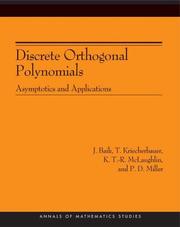
ISBN: 9780691127330 0691127336 9780691127347 0691127344 1400837138 1299224121 9781400837137 9781299224124 Year: 2007 Volume: 164 Publisher: Princeton, NJ
Abstract | Keywords | Export | Availability | Bookmark
 Loading...
Loading...Choose an application
- Reference Manager
- EndNote
- RefWorks (Direct export to RefWorks)
This book describes the theory and applications of discrete orthogonal polynomials--polynomials that are orthogonal on a finite set. Unlike other books, Discrete Orthogonal Polynomials addresses completely general weight functions and presents a new methodology for handling the discrete weights case. J. Baik, T. Kriecherbauer, K. T.-R. McLaughlin & P. D. Miller focus on asymptotic aspects of general, nonclassical discrete orthogonal polynomials and set out applications of current interest. Topics covered include the probability theory of discrete orthogonal polynomial ensembles and the continuum limit of the Toda lattice. The primary concern throughout is the asymptotic behavior of discrete orthogonal polynomials for general, nonclassical measures, in the joint limit where the degree increases as some fraction of the total number of points of collocation. The book formulates the orthogonality conditions defining these polynomials as a kind of Riemann-Hilbert problem and then generalizes the steepest descent method for such a problem to carry out the necessary asymptotic analysis.
Orthogonal polynomials --- Asymptotic theory --- Orthogonal polynomials -- Asymptotic theory. --- Polynomials. --- Civil & Environmental Engineering --- Engineering & Applied Sciences --- Operations Research --- Asymptotic theory. --- Asymptotic theory of orthogonal polynomials --- Algebra --- Airy function. --- Analytic continuation. --- Analytic function. --- Ansatz. --- Approximation error. --- Approximation theory. --- Asymptote. --- Asymptotic analysis. --- Asymptotic expansion. --- Asymptotic formula. --- Beta function. --- Boundary value problem. --- Calculation. --- Cauchy's integral formula. --- Cauchy–Riemann equations. --- Change of variables. --- Complex number. --- Complex plane. --- Correlation function. --- Degeneracy (mathematics). --- Determinant. --- Diagram (category theory). --- Discrete measure. --- Distribution function. --- Eigenvalues and eigenvectors. --- Equation. --- Estimation. --- Existential quantification. --- Explicit formulae (L-function). --- Factorization. --- Fredholm determinant. --- Functional derivative. --- Gamma function. --- Gradient descent. --- Harmonic analysis. --- Hermitian matrix. --- Homotopy. --- Hypergeometric function. --- I0. --- Identity matrix. --- Inequality (mathematics). --- Integrable system. --- Invariant measure. --- Inverse scattering transform. --- Invertible matrix. --- Jacobi matrix. --- Joint probability distribution. --- Lagrange multiplier. --- Lax equivalence theorem. --- Limit (mathematics). --- Linear programming. --- Lipschitz continuity. --- Matrix function. --- Maxima and minima. --- Monic polynomial. --- Monotonic function. --- Morera's theorem. --- Neumann series. --- Number line. --- Orthogonal polynomials. --- Orthogonality. --- Orthogonalization. --- Parameter. --- Parametrix. --- Pauli matrices. --- Pointwise convergence. --- Pointwise. --- Polynomial. --- Potential theory. --- Probability distribution. --- Probability measure. --- Probability theory. --- Probability. --- Proportionality (mathematics). --- Quantity. --- Random matrix. --- Random variable. --- Rate of convergence. --- Rectangle. --- Rhombus. --- Riemann surface. --- Special case. --- Spectral theory. --- Statistic. --- Subset. --- Theorem. --- Toda lattice. --- Trace (linear algebra). --- Trace class. --- Transition point. --- Triangular matrix. --- Trigonometric functions. --- Uniform continuity. --- Unit vector. --- Upper and lower bounds. --- Upper half-plane. --- Variational inequality. --- Weak solution. --- Weight function. --- Wishart distribution. --- Orthogonal polynomials - Asymptotic theory
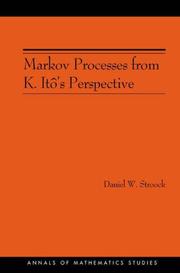
ISBN: 0691115427 1400835577 0691115435 1322063230 9781400835577 9781322063232 9780691115436 9870691115427 9780691115429 Year: 2003 Publisher: Princeton, NJ
Abstract | Keywords | Export | Availability | Bookmark
 Loading...
Loading...Choose an application
- Reference Manager
- EndNote
- RefWorks (Direct export to RefWorks)
Kiyosi Itô's greatest contribution to probability theory may be his introduction of stochastic differential equations to explain the Kolmogorov-Feller theory of Markov processes. Starting with the geometric ideas that guided him, this book gives an account of Itô's program. The modern theory of Markov processes was initiated by A. N. Kolmogorov. However, Kolmogorov's approach was too analytic to reveal the probabilistic foundations on which it rests. In particular, it hides the central role played by the simplest Markov processes: those with independent, identically distributed increments. To remedy this defect, Itô interpreted Kolmogorov's famous forward equation as an equation that describes the integral curve of a vector field on the space of probability measures. Thus, in order to show how Itô's thinking leads to his theory of stochastic integral equations, Stroock begins with an account of integral curves on the space of probability measures and then arrives at stochastic integral equations when he moves to a pathspace setting. In the first half of the book, everything is done in the context of general independent increment processes and without explicit use of Itô's stochastic integral calculus. In the second half, the author provides a systematic development of Itô's theory of stochastic integration: first for Brownian motion and then for continuous martingales. The final chapter presents Stratonovich's variation on Itô's theme and ends with an application to the characterization of the paths on which a diffusion is supported. The book should be accessible to readers who have mastered the essentials of modern probability theory and should provide such readers with a reasonably thorough introduction to continuous-time, stochastic processes.
Markov processes. --- Stochastic difference equations. --- Itō, Kiyosi, --- Analysis, Markov --- Chains, Markov --- Markoff processes --- Markov analysis --- Markov chains --- Markov models --- Models, Markov --- Processes, Markov --- Itō, K. --- Ito, Kiesi, --- Itō, Kiyoshi, --- 伊藤淸, --- 伊藤清, --- Itō, Kiyosi, --- Itō, Kiyosi, 1915-2008. --- Stochastic difference equations --- Difference equations --- Stochastic processes --- Abelian group. --- Addition. --- Analytic function. --- Approximation. --- Bernhard Riemann. --- Bounded variation. --- Brownian motion. --- Central limit theorem. --- Change of variables. --- Coefficient. --- Complete metric space. --- Compound Poisson process. --- Continuous function (set theory). --- Continuous function. --- Convergence of measures. --- Convex function. --- Coordinate system. --- Corollary. --- David Hilbert. --- Decomposition theorem. --- Degeneracy (mathematics). --- Derivative. --- Diffeomorphism. --- Differentiable function. --- Differentiable manifold. --- Differential equation. --- Differential geometry. --- Dimension. --- Directional derivative. --- Doob–Meyer decomposition theorem. --- Duality principle. --- Elliptic operator. --- Equation. --- Euclidean space. --- Existential quantification. --- Fourier transform. --- Function space. --- Functional analysis. --- Fundamental solution. --- Fundamental theorem of calculus. --- Homeomorphism. --- Hölder's inequality. --- Initial condition. --- Integral curve. --- Integral equation. --- Integration by parts. --- Invariant measure. --- Itô calculus. --- Itô's lemma. --- Joint probability distribution. --- Lebesgue measure. --- Linear interpolation. --- Lipschitz continuity. --- Local martingale. --- Logarithm. --- Markov chain. --- Markov process. --- Markov property. --- Martingale (probability theory). --- Normal distribution. --- Ordinary differential equation. --- Ornstein–Uhlenbeck process. --- Polynomial. --- Principal part. --- Probability measure. --- Probability space. --- Probability theory. --- Pseudo-differential operator. --- Radon–Nikodym theorem. --- Representation theorem. --- Riemann integral. --- Riemann sum. --- Riemann–Stieltjes integral. --- Scientific notation. --- Semimartingale. --- Sign (mathematics). --- Special case. --- Spectral sequence. --- Spectral theory. --- State space. --- State-space representation. --- Step function. --- Stochastic calculus. --- Stochastic. --- Stratonovich integral. --- Submanifold. --- Support (mathematics). --- Tangent space. --- Tangent vector. --- Taylor's theorem. --- Theorem. --- Theory. --- Topological space. --- Topology. --- Translational symmetry. --- Uniform convergence. --- Variable (mathematics). --- Vector field. --- Weak convergence (Hilbert space). --- Weak topology.
Book
ISBN: 0691081093 9781400871261 1400871263 9780691620114 9780691081090 0691620113 9780691081090 0691646945 Year: 1972 Volume: 11 Publisher: Princeton, N.J.
Abstract | Keywords | Export | Availability | Bookmark
 Loading...
Loading...Choose an application
- Reference Manager
- EndNote
- RefWorks (Direct export to RefWorks)
This book has as its subject the boundary value theory of holomorphic functions in several complex variables, a topic that is just now coming to the forefront of mathematical analysis. For one variable, the topic is classical and rather well understood. In several variables, the necessary understanding of holomorphic functions via partial differential equations has a recent origin, and Professor Stein's book, which emphasizes the potential-theoretic aspects of the boundary value problem, should become the standard work in the field.Originally published in 1972.The Princeton Legacy Library uses the latest print-on-demand technology to again make available previously out-of-print books from the distinguished backlist of Princeton University Press. These editions preserve the original texts of these important books while presenting them in durable paperback and hardcover editions. The goal of the Princeton Legacy Library is to vastly increase access to the rich scholarly heritage found in the thousands of books published by Princeton University Press since its founding in 1905.
Mathematical potential theory --- Holomorphic functions --- Harmonic functions --- Holomorphic functions. --- Harmonic functions. --- Fonctions de plusieurs variables complexes. --- Functions of several complex variables --- Functions, Harmonic --- Laplace's equations --- Bessel functions --- Differential equations, Partial --- Fourier series --- Harmonic analysis --- Lamé's functions --- Spherical harmonics --- Toroidal harmonics --- Functions, Holomorphic --- Absolute continuity. --- Absolute value. --- Addition. --- Ambient space. --- Analytic function. --- Arbitrarily large. --- Bergman metric. --- Borel measure. --- Boundary (topology). --- Boundary value problem. --- Bounded set (topological vector space). --- Boundedness. --- Brownian motion. --- Calculation. --- Change of variables. --- Characteristic function (probability theory). --- Combination. --- Compact space. --- Complex analysis. --- Complex conjugate. --- Computation. --- Conformal map. --- Constant term. --- Continuous function. --- Coordinate system. --- Corollary. --- Cramer's rule. --- Determinant. --- Diameter. --- Dimension. --- Elliptic operator. --- Estimation. --- Existential quantification. --- Explicit formulae (L-function). --- Exterior (topology). --- Fatou's theorem. --- Function space. --- Green's function. --- Green's theorem. --- Haar measure. --- Half-space (geometry). --- Harmonic function. --- Hilbert space. --- Holomorphic function. --- Hyperbolic space. --- Hypersurface. --- Hölder's inequality. --- Invariant measure. --- Invertible matrix. --- Jacobian matrix and determinant. --- Line segment. --- Linear map. --- Lipschitz continuity. --- Local coordinates. --- Logarithm. --- Majorization. --- Matrix (mathematics). --- Maximal function. --- Measure (mathematics). --- Minimum distance. --- Natural number. --- Normal (geometry). --- Open set. --- Order of magnitude. --- Orthogonal complement. --- Orthonormal basis. --- Parameter. --- Poisson kernel. --- Positive-definite matrix. --- Potential theory. --- Projection (linear algebra). --- Quadratic form. --- Quantity. --- Real structure. --- Requirement. --- Scientific notation. --- Sesquilinear form. --- Several complex variables. --- Sign (mathematics). --- Smoothness. --- Subgroup. --- Subharmonic function. --- Subsequence. --- Subset. --- Summation. --- Tangent space. --- Theorem. --- Theory. --- Total variation. --- Transitive relation. --- Transitivity. --- Transpose. --- Two-form. --- Unit sphere. --- Unitary matrix. --- Vector field. --- Vector space. --- Volume element. --- Weak topology.
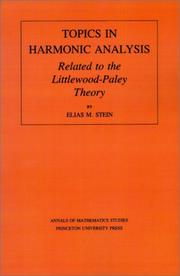
ISBN: 0691080674 1400881870 9780691080673 Year: 1970 Volume: 63 Publisher: Princeton, N. J.
Abstract | Keywords | Export | Availability | Bookmark
 Loading...
Loading...Choose an application
- Reference Manager
- EndNote
- RefWorks (Direct export to RefWorks)
This work deals with an extension of the classical Littlewood-Paley theory in the context of symmetric diffusion semigroups. In this general setting there are applications to a variety of problems, such as those arising in the study of the expansions coming from second order elliptic operators. A review of background material in Lie groups and martingale theory is included to make the monograph more accessible to the student.
Harmonic analysis. Fourier analysis --- Harmonic analysis --- Semigroups --- 517.986.6 --- Lie groups --- Littlewood-Paley theory --- #WWIS:d.d. Prof. L. Bouckaert/BOUC --- Fourier analysis --- Functions of several real variables --- Group theory --- Groups, Lie --- Lie algebras --- Symmetric spaces --- Topological groups --- Analysis (Mathematics) --- Functions, Potential --- Potential functions --- Banach algebras --- Calculus --- Mathematical analysis --- Mathematics --- Bessel functions --- Fourier series --- Harmonic functions --- Time-series analysis --- Harmonic analysis of functions of groups and homogeneous spaces --- Harmonic analysis. --- Littlewood-Paley theory. --- Lie groups. --- Semigroups. --- 517.986.6 Harmonic analysis of functions of groups and homogeneous spaces --- Addition. --- Analytic function. --- Axiom. --- Boundary value problem. --- Central limit theorem. --- Change of variables. --- Circle group. --- Classification theorem. --- Commutative property. --- Compact group. --- Complex analysis. --- Convex set. --- Coset. --- Covering space. --- Derivative. --- Differentiable manifold. --- Differential geometry. --- Differential operator. --- Dimension (vector space). --- Dimension. --- Direct sum. --- E6 (mathematics). --- E7 (mathematics). --- E8 (mathematics). --- Elementary proof. --- Equation. --- Equivalence class. --- Existence theorem. --- Existential quantification. --- Fourier analysis. --- Fourier series. --- Fourier transform. --- Function space. --- General linear group. --- Haar measure. --- Harmonic function. --- Hermite polynomials. --- Hilbert transform. --- Homogeneous space. --- Homomorphism. --- Ideal (ring theory). --- Identity matrix. --- Indecomposability. --- Integral transform. --- Invariant measure. --- Invariant subspace. --- Irreducibility (mathematics). --- Irreducible representation. --- Lebesgue measure. --- Legendre polynomials. --- Lie algebra. --- Lie group. --- Linear combination. --- Linear map. --- Local diffeomorphism. --- Markov process. --- Martingale (probability theory). --- Matrix group. --- Measurable function. --- Measure (mathematics). --- Multiple integral. --- Normal subgroup. --- One-dimensional space. --- Open set. --- Ordinary differential equation. --- Orthogonality. --- Orthonormality. --- Parseval's theorem. --- Partial differential equation. --- Probability space. --- Quadratic form. --- Rank of a group. --- Regular representation. --- Riemannian manifold. --- Riesz transform. --- Schur orthogonality relations. --- Scientific notation. --- Semigroup. --- Sequence. --- Special case. --- Stone–Weierstrass theorem. --- Sturm–Liouville theory. --- Subgroup. --- Subset. --- Summation. --- Tensor algebra. --- Tensor product. --- Theorem. --- Theory. --- Topological group. --- Topological space. --- Torus. --- Trigonometric polynomial. --- Trivial representation. --- Uniform convergence. --- Unitary operator. --- Unitary representation. --- Vector field. --- Vector space. --- Lie, Groupes de --- Analyse harmonique

ISBN: 0691081565 1400881617 9780691081564 Year: 1975 Volume: 83 Publisher: Princeton, N. J.
Abstract | Keywords | Export | Availability | Bookmark
 Loading...
Loading...Choose an application
- Reference Manager
- EndNote
- RefWorks (Direct export to RefWorks)
This volume investigates the interplay between the classical theory of automorphic forms and the modern theory of representations of adele groups. Interpreting important recent contributions of Jacquet and Langlands, the author presents new and previously inaccessible results, and systematically develops explicit consequences and connections with the classical theory. The underlying theme is the decomposition of the regular representation of the adele group of GL(2). A detailed proof of the celebrated trace formula of Selberg is included, with a discussion of the possible range of applicability of this formula. Throughout the work the author emphasizes new examples and problems that remain open within the general theory.TABLE OF CONTENTS: 1. The Classical Theory 2. Automorphic Forms and the Decomposition of L2(PSL(2,R) 3. Automorphic Forms as Functions on the Adele Group of GL(2) 4. The Representations of GL(2) over Local and Global Fields 5. Cusp Forms and Representations of the Adele Group of GL(2) 6. Hecke Theory for GL(2) 7. The Construction of a Special Class of Automorphic Forms 8. Eisenstein Series and the Continuous Spectrum 9. The Trace Formula for GL(2) 10. Automorphic Forms on a Quaternion Algebr?
Number theory --- Representations of groups --- Linear algebraic groups --- Adeles --- Representations of groups. --- Automorphic forms. --- Linear algebraic groups. --- Adeles. --- Nombres, Théorie des --- Formes automorphes --- Automorphic forms --- Algebraic fields --- Algebraic groups, Linear --- Geometry, Algebraic --- Group theory --- Algebraic varieties --- Automorphic functions --- Forms (Mathematics) --- Group representation (Mathematics) --- Groups, Representation theory of --- Nombres, Théorie des. --- Abelian extension. --- Abelian group. --- Absolute value. --- Addition. --- Additive group. --- Algebraic group. --- Algebraic number field. --- Algebraic number theory. --- Analytic continuation. --- Analytic function. --- Arbitrarily large. --- Automorphic form. --- Cartan subgroup. --- Class field theory. --- Complex space. --- Congruence subgroup. --- Conjugacy class. --- Coprime integers. --- Cusp form. --- Differential equation. --- Dimension (vector space). --- Direct integral. --- Direct sum. --- Division algebra. --- Eigenfunction. --- Eigenvalues and eigenvectors. --- Eisenstein series. --- Euler product. --- Existential quantification. --- Exponential function. --- Factorization. --- Finite field. --- Formal power series. --- Fourier series. --- Fourier transform. --- Fuchsian group. --- Function (mathematics). --- Function space. --- Functional equation. --- Fundamental unit (number theory). --- Galois extension. --- Global field. --- Group algebra. --- Group representation. --- Haar measure. --- Harish-Chandra. --- Hecke L-function. --- Hilbert space. --- Homomorphism. --- Induced representation. --- Infinite product. --- Inner automorphism. --- Integer. --- Invariant measure. --- Invariant subspace. --- Irreducible representation. --- L-function. --- Lie algebra. --- Linear map. --- Matrix coefficient. --- Mellin transform. --- Meromorphic function. --- Modular form. --- P-adic number. --- Poisson summation formula. --- Prime ideal. --- Prime number. --- Principal series representation. --- Projective representation. --- Quadratic field. --- Quadratic form. --- Quaternion algebra. --- Quaternion. --- Real number. --- Regular representation. --- Representation theory. --- Ring (mathematics). --- Ring of integers. --- Scientific notation. --- Selberg trace formula. --- Simple algebra. --- Square-integrable function. --- Sub"ient. --- Subgroup. --- Summation. --- Theorem. --- Theory. --- Theta function. --- Topological group. --- Topology. --- Trace formula. --- Trivial representation. --- Uniqueness theorem. --- Unitary operator. --- Unitary representation. --- Universal enveloping algebra. --- Upper half-plane. --- Variable (mathematics). --- Vector space. --- Weil group. --- Nombres, Théorie des
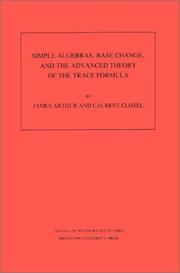
ISBN: 0691085188 069108517X 1400882400 Year: 1989 Volume: vol 120 Publisher: Princeton University Press
Abstract | Keywords | Export | Availability | Bookmark
 Loading...
Loading...Choose an application
- Reference Manager
- EndNote
- RefWorks (Direct export to RefWorks)
A general principle, discovered by Robert Langlands and named by him the "functoriality principle," predicts relations between automorphic forms on arithmetic subgroups of different reductive groups. Langlands functoriality relates the eigenvalues of Hecke operators acting on the automorphic forms on two groups (or the local factors of the "automorphic representations" generated by them). In the few instances where such relations have been probed, they have led to deep arithmetic consequences. This book studies one of the simplest general problems in the theory, that of relating automorphic forms on arithmetic subgroups of GL(n,E) and GL(n,F) when E/F is a cyclic extension of number fields. (This is known as the base change problem for GL(n).) The problem is attacked and solved by means of the trace formula. The book relies on deep and technical results obtained by several authors during the last twenty years. It could not serve as an introduction to them, but, by giving complete references to the published literature, the authors have made the work useful to a reader who does not know all the aspects of the theory of automorphic forms.
511.33 --- Analytical and multiplicative number theory. Asymptotics. Sieves etc. --- 511.33 Analytical and multiplicative number theory. Asymptotics. Sieves etc. --- Automorfe vormen --- Automorphic forms --- Formes automorphes --- Representation des groupes --- Representations of groups --- Trace formulas --- Vertegenwoordiging van groepen --- Formulas, Trace --- Discontinuous groups --- Group representation (Mathematics) --- Groups, Representation theory of --- Group theory --- Automorphic functions --- Forms (Mathematics) --- Analytical and multiplicative number theory. Asymptotics. Sieves etc --- Representations of groups. --- Trace formulas. --- Automorphic forms. --- 0E. --- Addition. --- Admissible representation. --- Algebraic group. --- Algebraic number field. --- Approximation. --- Archimedean property. --- Automorphic form. --- Automorphism. --- Base change. --- Big O notation. --- Binomial coefficient. --- Canonical map. --- Cartan subalgebra. --- Cartan subgroup. --- Central simple algebra. --- Characteristic polynomial. --- Closure (mathematics). --- Combination. --- Computation. --- Conjecture. --- Conjugacy class. --- Connected component (graph theory). --- Continuous function. --- Contradiction. --- Corollary. --- Counting. --- Coxeter element. --- Cusp form. --- Cyclic permutation. --- Dense set. --- Density theorem. --- Determinant. --- Diagram (category theory). --- Discrete series representation. --- Discrete spectrum. --- Division algebra. --- Eigenvalues and eigenvectors. --- Eisenstein series. --- Exact sequence. --- Existential quantification. --- Field extension. --- Finite group. --- Finite set. --- Fourier transform. --- Functor. --- Fundamental lemma (Langlands program). --- Galois extension. --- Galois group. --- Global field. --- Grothendieck group. --- Group representation. --- Haar measure. --- Harmonic analysis. --- Hecke algebra. --- Hilbert's Theorem 90. --- Identity component. --- Induced representation. --- Infinite product. --- Infinitesimal character. --- Invariant measure. --- Irreducibility (mathematics). --- Irreducible representation. --- L-function. --- Langlands classification. --- Laurent series. --- Lie algebra. --- Lie group. --- Linear algebraic group. --- Local field. --- Mathematical induction. --- Maximal compact subgroup. --- Multiplicative group. --- Nilpotent group. --- Orbital integral. --- P-adic number. --- Paley–Wiener theorem. --- Parameter. --- Parametrization. --- Permutation. --- Poisson summation formula. --- Real number. --- Reciprocal lattice. --- Reductive group. --- Root of unity. --- Scientific notation. --- Semidirect product. --- Special case. --- Spherical harmonics. --- Subgroup. --- Subset. --- Summation. --- Support (mathematics). --- Tensor product. --- Theorem. --- Trace formula. --- Unitary representation. --- Weil group. --- Weyl group. --- Zero of a function.
Book
ISBN: 0691141843 0691141851 9786612303807 1282303805 1400831067 9781400831067 9781282303805 9780691141848 9780691141855 Year: 2009 Volume: 172 Publisher: Princeton, NJ
Abstract | Keywords | Export | Availability | Bookmark
 Loading...
Loading...Choose an application
- Reference Manager
- EndNote
- RefWorks (Direct export to RefWorks)
The results established in this book constitute a new departure in ergodic theory and a significant expansion of its scope. Traditional ergodic theorems focused on amenable groups, and relied on the existence of an asymptotically invariant sequence in the group, the resulting maximal inequalities based on covering arguments, and the transference principle. Here, Alexander Gorodnik and Amos Nevo develop a systematic general approach to the proof of ergodic theorems for a large class of non-amenable locally compact groups and their lattice subgroups. Simple general conditions on the spectral theory of the group and the regularity of the averaging sets are formulated, which suffice to guarantee convergence to the ergodic mean. In particular, this approach gives a complete solution to the problem of establishing mean and pointwise ergodic theorems for the natural averages on semisimple algebraic groups and on their discrete lattice subgroups. Furthermore, an explicit quantitative rate of convergence to the ergodic mean is established in many cases. The topic of this volume lies at the intersection of several mathematical fields of fundamental importance. These include ergodic theory and dynamics of non-amenable groups, harmonic analysis on semisimple algebraic groups and their homogeneous spaces, quantitative non-Euclidean lattice point counting problems and their application to number theory, as well as equidistribution and non-commutative Diophantine approximation. Many examples and applications are provided in the text, demonstrating the usefulness of the results established.
Dynamics. --- Ergodic theory. --- Harmonic analysis. --- Lattice theory. --- Lie groups. --- Ergodic theory --- Lie groups --- Lattice theory --- Harmonic analysis --- Dynamics --- Calculus --- Mathematics --- Physical Sciences & Mathematics --- Dynamical systems --- Kinetics --- Analysis (Mathematics) --- Functions, Potential --- Potential functions --- Lattices (Mathematics) --- Space lattice (Mathematics) --- Structural analysis (Mathematics) --- Groups, Lie --- Ergodic transformations --- Mechanics, Analytic --- Force and energy --- Mechanics --- Physics --- Statics --- Banach algebras --- Mathematical analysis --- Bessel functions --- Fourier series --- Harmonic functions --- Time-series analysis --- Algebra, Abstract --- Algebra, Boolean --- Group theory --- Set theory --- Topology --- Transformations (Mathematics) --- Crystallography, Mathematical --- Lie algebras --- Symmetric spaces --- Topological groups --- Continuous groups --- Mathematical physics --- Measure theory --- Absolute continuity. --- Algebraic group. --- Amenable group. --- Asymptote. --- Asymptotic analysis. --- Asymptotic expansion. --- Automorphism. --- Borel set. --- Bounded function. --- Bounded operator. --- Bounded set (topological vector space). --- Congruence subgroup. --- Continuous function. --- Convergence of random variables. --- Convolution. --- Coset. --- Counting problem (complexity). --- Counting. --- Differentiable function. --- Dimension (vector space). --- Diophantine approximation. --- Direct integral. --- Direct product. --- Discrete group. --- Embedding. --- Equidistribution theorem. --- Ergodicity. --- Estimation. --- Explicit formulae (L-function). --- Family of sets. --- Haar measure. --- Hilbert space. --- Hyperbolic space. --- Induced representation. --- Infimum and supremum. --- Initial condition. --- Interpolation theorem. --- Invariance principle (linguistics). --- Invariant measure. --- Irreducible representation. --- Isometry group. --- Iwasawa group. --- Lattice (group). --- Lie algebra. --- Linear algebraic group. --- Linear space (geometry). --- Lipschitz continuity. --- Mass distribution. --- Mathematical induction. --- Maximal compact subgroup. --- Maximal ergodic theorem. --- Measure (mathematics). --- Mellin transform. --- Metric space. --- Monotonic function. --- Neighbourhood (mathematics). --- Normal subgroup. --- Number theory. --- One-parameter group. --- Operator norm. --- Orthogonal complement. --- P-adic number. --- Parametrization. --- Parity (mathematics). --- Pointwise convergence. --- Pointwise. --- Principal homogeneous space. --- Principal series representation. --- Probability measure. --- Probability space. --- Probability. --- Rate of convergence. --- Regular representation. --- Representation theory. --- Resolution of singularities. --- Sobolev space. --- Special case. --- Spectral gap. --- Spectral method. --- Spectral theory. --- Square (algebra). --- Subgroup. --- Subsequence. --- Subset. --- Symmetric space. --- Tensor algebra. --- Tensor product. --- Theorem. --- Transfer principle. --- Unit sphere. --- Unit vector. --- Unitary group. --- Unitary representation. --- Upper and lower bounds. --- Variable (mathematics). --- Vector group. --- Vector space. --- Volume form. --- Word metric.
| Listing 1 - 9 of 9 |
Sort by
|

 Search
Search Feedback
Feedback About UniCat
About UniCat  Help
Help News
News